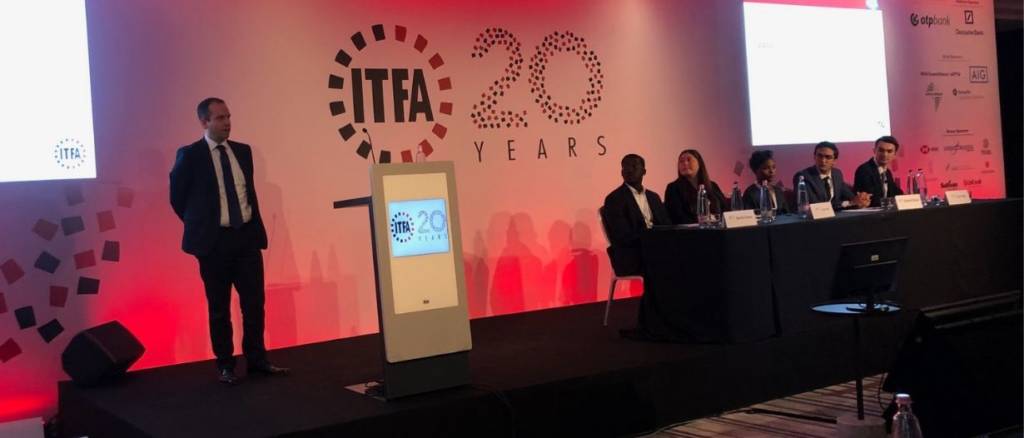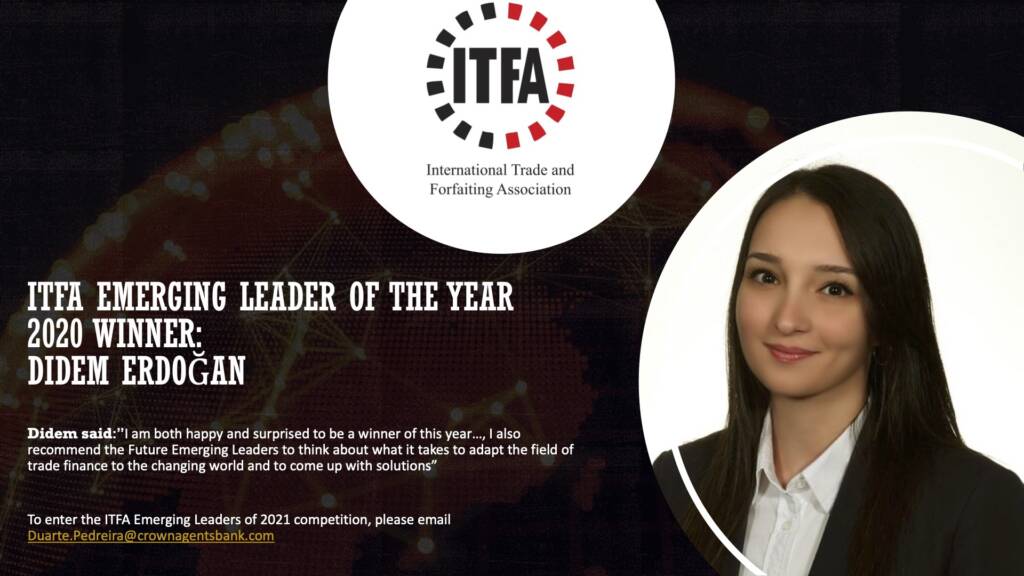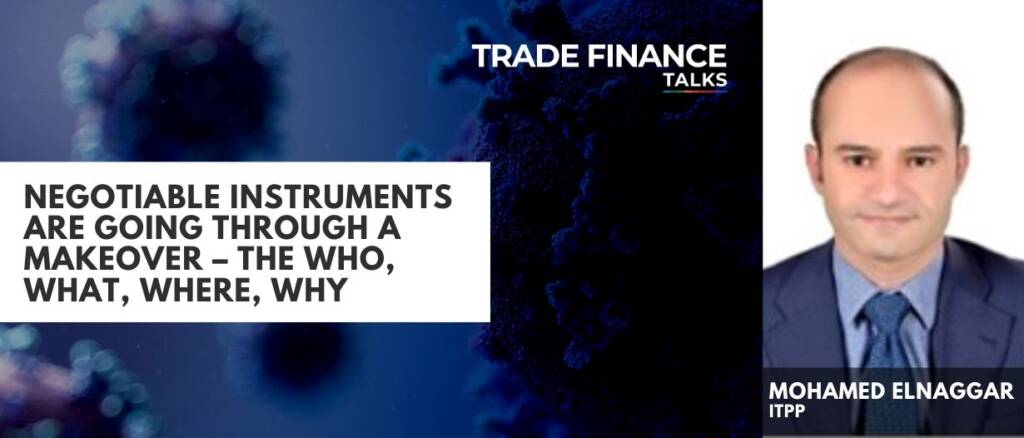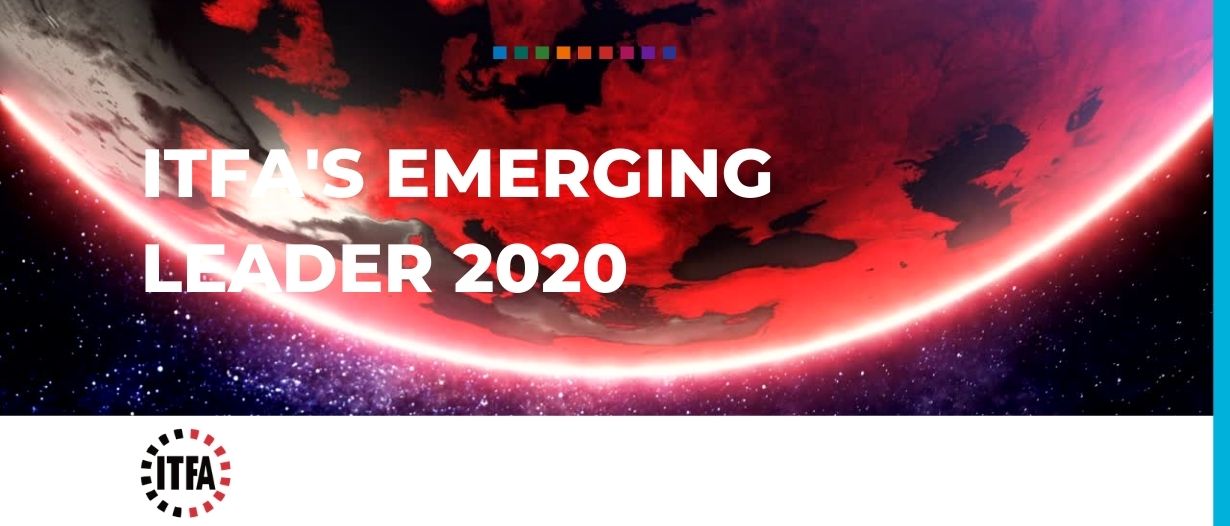Promoting and nurturing emerging talent within the trade finance sector remains a universal challenge which needs to be addressed. Raising the profile of trade finance for the next generation transaction banking professionals is crucial to ensure the industry’s future. Today the winner of the ITFA Emerging Leader 2020 competition was announced – we report on the shortlisted and winning entries. TFG thanks Charlotte Prior, Michel Meylacq and the ITFA Emerging Leaders Committee for their contributions in putting together this article.
Earlier this year, ITFA’s Emerging Leaders Committee called out for trade finance projects and submissions for their annual competition. 2020 saw 19 impressive projects submitted. Once shortlisted down to five, voting commenced, with the industry assessing the project that would bring about the most significant contribution to the trade finance industry. TFG showcases the frontrunners, as well as this yeas’ winner, bagging the title ‘ITFA Emerging Leader 2020‘.
Duarte Pedreira, Chair, ITFA Emerging Leaders and Sean Edwards, Chairman, ITFA, told TFG: “One of ITFA’s critical undertakings is to prepare the next generation of trade financiers. Over the last three years the association has placed a significant effort in the development of its Emerging Leaders initiative and, as a result, we became the most active platform for the promotion of young talent in the trade finance industry. The ITFA Emerging Trade Financier of the Year Award is a corollary of this and in 2020 we really raised the bar with 19 projects submitted for the jury to consider, making this one of the most sought after accolades in the trade finance world.”
Rules of the game
The rules of the competition were simple: applicants had to be an Emerging Leader, and the project must bring about a significant contribution to the Trade Finance industry. Projects took many formats and were judged on their relevance and quality of content, level of innovation, accessibility, and creativity.
Charlotte Prior, Emerging Leaders Committee Member and part of the winning group from last years’ ITFA Young Professional’s competition, and Michel Meylacq, Emerging Leaders Committee Member, said: “The idea of the competition is to give an opportunity for efforts of young talents of the Trade Finance industry to be recognised, with winners receiving a certificate of achievement and an invitation to attend the ITFA Annual Conference.”
Following TFG’s coverage of the ITFA Young Professional competition last year, held in Budapest, Hungary, we uncovered the adapted (online) version of the competition.

Outline
- Julian Heaven – A guide to trade finance law
- Alex Mearing – Supporting SME trade using microfinance
- Team Texel – The Lifecycle of a Trade
- Alejandro Battistotti – A new asset class in trade finance?
- Didem Erdogan – ECA support for software exporters
- Mohammed Elnaggar – Negotiable Instruments are going through a makeover
The Runners Up

Julian Heaven – A guide to trade finance law
Name: Julian Heaven
Position and Company: Vice President – Trade Finance, Scipion Capital
Project Title: A guide to trade finance law
Bio: Before joining the Trade Desk at Scipion Capital in September 2019, Julian held other positions within the industry where he was responsible for structuring, executing, and managing trade finance facilities through their lifecycle. Julian has gained exposure to a wide range of asset classes, geographies, and trade finance products during his professional career and is supported by a Bachelor of Science degree in Economics from the University of York, England.
Julian’s guide included an introduction to different legal systems, an African regional case study, interviews with preeminent trade finance lawyers and a practical section giving industry specific advice on how best to approach a transaction in an unfamiliar jurisdiction. The objective of the guide was to provide new recruits with a basic theoretical, historical, and applicative understanding of law from a trade finance perspective.
Julian said: “I believe that Trade Finance is a social science which requires as much of an understanding about economics as it does geography and law. For example, take climatology, a subfield of physical geography dedicated to the study of weather patterns. Arguably, understanding this branch of geography is as important as understanding any branch of economics when it comes to analysing soft commodity trades.”
“Ultimately, I believe that for our sector to survive the looming exodus of talent, that the 38% of us that remain in the industry with less than 10 years’ experience will need to pool and leverage our collective knowledge. And so this is how I came to write a guide on Trade Finance Law aimed at helping new recruits within the sector navigate the jurisdictions in which they operate and the challenges they may face in the process.”
Related content
Podcast: Sullivan – Moving forward with Credit Insurance: Mitigating Risk in Trade Finance
Alex Mearing – Supporting SME trade using microfinance
Name: Alex Mearing
Position and Company: Postgraduate research candidate at the University of Cambridge
Project Title: Microfinance-based trade solution to remove credit risk contstraints for banks & supporting SME trade during unstable times
Bio: Alex Mearing is currently a postgraduate research candidate at the University of Cambridge, interested in Evolutionary & Cognitive Sciences. He previously worked at American International Group (AIG) as a Trade Finance Risk Underwriter. He holds a Bachelor of Science degree from the University of Durham and certificate level membership of the Chartered Insurance Institute.
Alex’s proposition was the production of a website interface in the microfinance tradition, which involved funders as partner institutions, and which approaches all the below problems.
The website would couple domestic businesses with interested donators. However, instead of the funds going directly to the business, they would be held in an escrow account. Interested funders would then conduct their due diligence on the business & trade flows and would onboard the beneficiary as a client. The funder would then finance the trade directly whilst using the escrow funds as full/partial security on which they can call on in the event of default. Otherwise, the donated security funds are returned to the donators at maturity.
Alex said: “I’ve been interested in crowd-based financial solutions for some time and it strikes me that there is real potential unexplored, particularly for open account trade. What piqued my interest specifically is that this product has observed a 98% repayment rate despite the apparent obstacles.
“Two of the key factors driving the trade finance gap are credit risk and SME knowledge of trade products. The primary benefit of structuring a crowd-based financial solution like this is that, unlike a single donator-donatee loan, the escrow security can be used to secure the financing of a potentially infinite volume of repeated trade flows under the same donation. In addition, though donations are charitable, there is likely to be an extremely high repayment rate. This solution could a) hedge/remove obligor credit risk and thereby permit greater funding volumes and b) encourage new client relationships, thereby increasing the wider understanding of trade products, potentially cushioning the fallout from COVID-19 and supporting trade into the future.”
Related content
Tradecast – Count us in! MSME inclusion in global trade
News – Finastra helps redefine the future of finance to improve millions of lives worldwide
Article – Gender Inequality in India. Can Microcredit Help?
Team Texel – The Lifecycle of a Trade
Names: Anna Rogers, Nick Rango, Max Walker, Priyanka Thakrar, Georgina Barrett
Company: Texel Group
Project Title: Video: The lifecycle of a trade
Bio: We are a team of Credit and Political Risk Brokers from the Texel Group. We are based across Texel’s teams in London and New York, and each have experience of 1-3 years with the Group. As part of our role as brokers, we work to support our clients (who include financial institutions, commodity traders, corporates and multilaterals) through providing expertly structured products.
The group have produced a short video to document the ‘life cycle’ of a trade. Everybody who joins the trade finance industry will be very familiar with the traditional diagram of how a Letter of Credit operates – this is certainly something which all new starters at Texel will go through many times when they begin their careers.
The team said told TFG: Whilst not attempting to reinvent the wheel we chose to address the most basic and fundamental mechanics of the Trade Finance Industry in a modern and comprehensive way. ITFA and the Emerging Leaders programme have a responsibility to ensure that our industry continues to attract top talent and grows, our project aims to make that first step towards the sector all the easier and more accessible.
We thought that it would be useful to produce a diagram which includes a credit insurance policy purchased by a Confirming Bank operating alongside this, to show how CRI can be a useful and effective tool for banks operating in the trade finance space. There is scope to expand the diagram to also indicate how credit insurance can also benefit other parties in the trade, including the issuing bank and exporter, but for simplicity’s sake we have kept to the Confirming Bank only.
Related content
Podcast – Texel – KYP (Know Your Policy) – Learnings from CPRI in a post-Covid world
Article – Lloyd’s of London Interview: The £5bn Covid-19 payout
Alejandro Battistotti – A new asset class in trade finance?
Name: Alejandro Battistotti
Position and Company: Portfolio Managed, Structured Private Debt, NN Investment Partners
Project Title: A new asset class in trade finance?
Bio: Alejandro Battistotti is a Portfolio Manager in the Structure Private Debt team at NN Investment Partners, a Dutch asset manager. His main focus is structuring export, trade and receivables finance transactions for institutional investors across Europe. Alejandro is a qualified attorney and holds a Master in Law from the University of Cambridge. Having started his career at JP Morgan Private Bank in the UK, his interest in the financial markets and deal making motivated him to move into a derivatives sales and trading role with an Amsterdam based investment firm. In 2018, he moved into the buy-side with NN Investment Partners in the Hague. Alejandro lives in the Hague and he is originally from Buenos Aires, Argentina.
Alejandro’s project is called ‘A New Asset Class in Trade Finance?’ and it proposed the notion that if properly structured to appeal to institutional investors, trade receivables and trade finance assets in general, can become a new trillion-dollar institutional asset class and potentially a way of tackling the Trade Finance gap.
The paper explored how the interplay between the Basel Capital Framework and Solvency II created the necessary platform for non-bank capital to finance the real economy. The regulatory design which has been pressed forward by COVID19 economic downturn has increased the trade finance gap and the need for working capital, widening spread for TF assets and creating further financial incentive on top of the aforementioned regulatory intention. In a negative rates environment, trade receivables (and trade finance assets in general) present a superb relative value opportunity for institutional investors. The main idea of the paper, however, is that no matter how attractive this opportunity seems, most institutional investors may not wish to digest each and every of risk inherent to financing the real economy and hence the need to properly structure Trade Finance assets in a way that is coherent with the risk, capital and operational considerations that affect institutional investors.
Alejandro said: “If properly structured, Trade Finance assets offer a superb relative value opportunity versus traditional credit while being extremely efficient from Solvency Capital perspective. The project underlying premise is that the regulation and the market came to the point in which Trade Finance players have to embrace capital market standards if they want to financeable and institutional investors need to embrace the real economy if they want positive returns. If these is achieved the trade finance gap might be solved for good.”
Related content
Clyde & Co Video: Are there enough trade assets to finance in the market and are there liquidity issues?
Article: EBA Chairperson Exclusive, on Basel III for SMEs, CRD and the CRR ‘Quick Fix’

And the winner is…Didem Erdogan
Didem Erdogan – ECA support for software exporters
Name: Didem Erdogan
Position and Company: Specialist, International Loans, Turk Eximbank
Project Title: ECA support for software exporters – status quo and suggestions for the future
Bio: Didem Erdoğan, born in Istanbul, Turkey, in 1991, holds a Bachelor’s degree in Economics from Istanbul University and Master’s degree in Information Technology from Sabancı University. She also studied Economics at the Universidad de Valencia, Spain, for 1 year with the Erasmus Exchange program. During her school years, she did several internships at various public institutions, such as The Central Bank of Turkey, Istanbul Stock of Exchange and the Capital Markets Board of Turkey. She began her career at the Turkish Statistical Institute in March 2016 and at the end of the same year, she began to take charge as an Assistant Specialist in Turk Eximbank which is the only official Export Credit Agency in Turkey. In 2020, she was promoted to Specialist by presenting a comprehensive thesis regarding global practices in software export finance and insurance support. She is also a part of the “Women Leaders of the Future” project launched by KAGIDER (Women Entrepreneurs Association of Turkey) which is a non-governmental organization aimed at strengthening women entrepreneurs.
With the growth of international trade software, Erdogan’s project aimed to understand Export Credit Agencies’ (ECAs) export credit and insurance support for the software sector. She conducted research of 51 ECAs / Development Banks all around the world, and also conducted a survey where 71 current or potential software exporters participated to accurately identify the needs of the software exporters.
The results of the research showed that whether related to credit or insurance, it was obvious that software export is not sufficiently supported by the ECAs whose main goal it is to contribute their national export volumes. The barriers for supporting software by the ECA’s around the world stem from one fundamental difference: there are no procedures that are appropriate for the different nature of software as an export item. As a solution, I came up with an idea that it is necessary to first establish a standardization in classification and measurement method and then to introduce new solutions in line with the needs of software exporters so that ECAs would be able to easily support software exports, and thanks to this success, many countries will benefit from converting themselves to the information society and the increase in world trade volume.
Didem said: “I am both happy and surprised to be a winner of this year since Software Export Support in the trade finance area is not generally sufficiently supported, especially by the Export Credit Agencies. However, from this point of view, I can say that distinguishing deficiencies in the trade finance and ponder for the correction of them makes a huge difference. In this sense, I also recommend the Future Emerging Leaders to think about what it takes to adapt the field of trade finance to the changing world and to come up with solutions.
The software industry, which is becoming more and more important with the impact of digitalization, globalization and other transformations, has become a part of daily lives with the Industry 4.0 concept. The ever-marching spread of the internet, the ease of storage, streaming and processing services have all contributed to the further development of the software industry. Nowadays, every item used is made “smart” thanks to software, and the economies of the countries are leaping forward with the successes in this industry.
Moreover, in less than a century the software market has shown a sharp increase by reaching a multi-billion-dollar industry, and even if trade volumes of software are significantly underestimated – because its trade is usually based on the value of physical goods rather than content and is often bundled with computer hardware – while the share of telecommunications services has declined, computer services receipts have reached more than double in value between 2008 and 2018.”
Related content
Video: SCHUMANN’s Robert Meters – Rethinking Credit Risk Management in 2020 and Beyond
Article: UK ECA (UKEF), on how EXIP policies can help bridge the financing gap
A special mention to: Mohamed Elnaggar

Mohammed Elnaggar – Negotiable Instruments are going through a makeover
Name: Mohammed Elnaggar
Position and Company: Head of Trade Finance Control Unit, National Bank of Egypt
Project Title: Negotiable Instruments are going through a makeover – the who, what, where, why
Bio: Mohamed is a trade finance passionate with experience for about 15 years in the banking industry, who is looking forward to expanding his knowledge by getting exposed to new challenges, providing new trade finance solutions, and spreading knowledge to the new trade finance practitioners. Mohamed is also a member of the 2020 cohort for Trade Finance Global’s International Trade Professionals Programme (ITPP).
Mohamed’s article “Negotiable Instruments are going through a makeover – the who, what, where, why” was written for Trade Finance Global and published in Trade Finance Talks. The program aims to introduce new trade finance writers by allowing them to express their thoughts through producing a professional journalistic piece of content on pre-agreed topics defined by their editorial team.
Blockchain technology has been described as a game-changer in trade finance for its capacity to digitize the most complicated sector. But legal challenges hamper the transformation process, as current outdated laws in most countries and jurisdictions do not recognize the digital version of the negotiable instruments.
Mohamed said: “The article emphasizes the importance of negotiable instruments and their role in trade and supply chain finance. It sheds light on the current initiatives and efforts by market players like the ICC, BAFT, ITFA, and other technology providers who have up and running solutions that cover the legal concerns and ensure authenticity, traceability, security, and credibility.”
“The article raises a call to governments, law-makers, and other stakeholders to accelerate the adoption of “UNCITRAL MLETR” provisions besides applying the standards for verifying the electronic signature and other security aspects which will expedite the digital transformation in trade finance and cover the legal concerns.”
Related content
Whitepaper: DLT & Blockchain for Trade: Where do we stand (WTO / TFG)
Article: China Systems: The Letter of Credit: A candle in the wind?
Article: The “key” to digital trade finance: Public Key Cryptography explained
Pedreira and Edwards added: “We would like to congratulate all of those who took part in this year’s competition, with a special emphasis to the 5 shortlisted projects and of course, Didem Erdogan from Turkexim Bank for winning in the brilliant way she did. Our commitment will continue to be focused on providing these Emerging Leaders with the visibility, knowledge and career tools they need to effectively become the next generation of industry leaders in trade finance.”
Members of ITFA can see the presentations of all runners up and the winners entry here.
 Australia
Australia Hong Kong
Hong Kong Japan
Japan Singapore
Singapore United Arab Emirates
United Arab Emirates United States
United States France
France Germany
Germany Ireland
Ireland Netherlands
Netherlands United Kingdom
United Kingdom













Comments are closed.